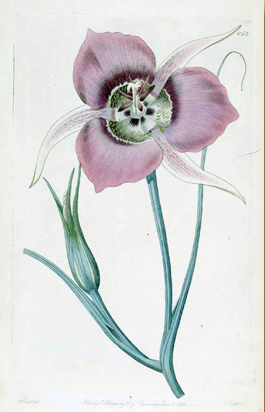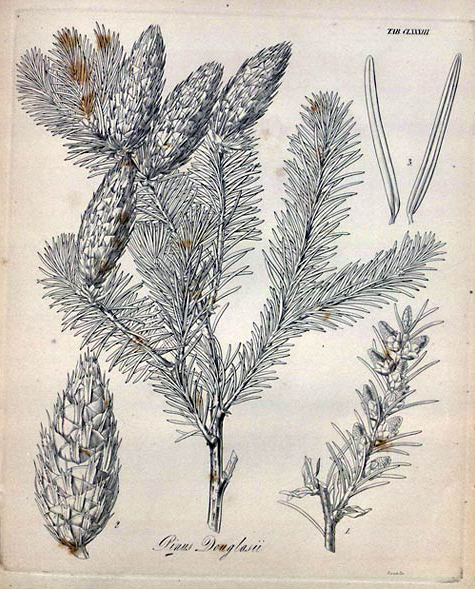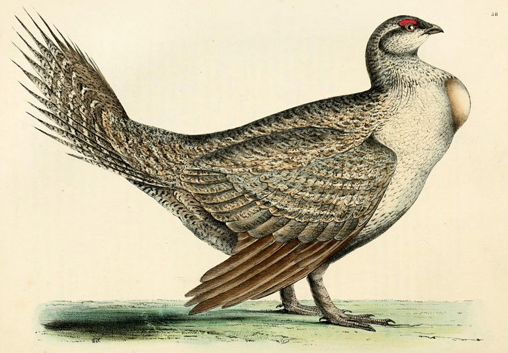In London, David Douglas wrote or contributed to more than a dozen scientific papers building on the prior collections of Lewis and Clark.
From the London Papers
Mariposa Lily Calochortus macrocarpus
Edwards’s Botanical Register, vol. 14 (1828), plate 1152. Figure by M. Hart; engraving by J. Watts.
“In the summer of 1826 I observed it in abundance on the banks of the southern branches of the Columbia, towards their sources in the mountains, growing luxuriantly.”[1]Ibid., 277.
David Douglas returned to England via the overland fur trade route, crossing the Rocky Mountains and Canadian Prairies to sail from Hudson Bay. He arrived in London in late fall 1827, and with many hundreds of flora and fauna specimens to process, as well as a book contract calling for a narrative of his adventures, he remained there for two years before undertaking a second expedition to the New World. During his stay he wrote or contributed to more than a dozen scientific papers, several of which build on the seminal first collections of Lewis and Clark.
The Mariposa Lily
Typical of these is a line from a paper on the sumptuous mariposa lilies (genus Calochortus) that thrive in the Columbia’s interior. “We derived our knowledge of this hitherto little known Genus of Plants from Pursh . . . from a solitary specimen found by Lewis and Clarke in their expedition across the continent, during the years 1804, 5, and 6, in the recesses of the rocky mountains, and west of them, towards the waters of the Pacific Ocean . . . ” After this gracious nod to his predecessors, Douglas made sure that he surpassed them in the very next sentence. “In the course of my late journey through the districts adjoining the River Columbia, I was fortunate enough to find the species already described by Pursh, and two others, not before observed, I am enabled to give some additional information respecting this interesting and highly ornamental Genus.”[2]David Douglas, “An Account of the Species of Calochortus; a Genus of American Plants.” Transactions of the Horticultural Society, 7 (1830): 275.
The Bitterroot
For bitterroot (Lewisia rediviva), a genus that carries Meriwether Lewis‘s own name, Douglas explained the Latin species definition from personal experience. “The roots of this are gathered in great quantities by the Indians on the west side of the Rocky Mountains, and highly valued on account of their nutritive quality. They are boiled and eaten as Salep, or arrow-root, and are admirably calculated for carrying on long journies: two or three ounces a day being sufficient for a man, even while undergoing great fatigue.”[3]Hooker, 1:223.
The Douglas-fir
Douglas-fir Pseudotsuga menziesii
William Jackson Hooker, Flora Boreali-Americana, vol. 2 (1829), plate 183. Drawn and engraved by William Hooker.
“Wood straight and regular in the grain, fine, heavy, and easily split. . . . Whether it will prove durable or not remains yet to be known.”[4]Ibid., 339.
As part of Douglas’s job description, he sent back the seed for numerous conifers that forever altered commercial forests in Great Britain and all her temperate colonies. Foremost among those is the tree that bears his name, and in his treatment of Douglas-fir he kindly challenged Lewis and Clark’s estimate of three hundred feet for the height of one tree. “After a two year’s residence, during which time I measured any tree that appeared from its magnitude as interesting, I was unable to find any from actual measurements exceeding the height [of 227 feet].”[5]Journal, “Some American Pines,” 340-41. (For a full treatment of the name changes that this species has undergone in the succeeding two centuries, see James Reveal’s Douglas-fir, a nomenclatural morass.)
The Sage Grouse
Greater Sage Grouse Centrocercus urophasianus
William Swainson & John Richardson, Fauna Boreali-Americana, vol. 2 (1831), plate 58.
Drawn and engraved by William Swainson.
“The pair in March and April. The wings of the male bird are lowered, buzzing on the ground, the tail spread like a fan, somewhat erect; the bare yellow oesohagus inflated to a prodigious size.”[6]Ibid., 135.
Like the captains, Douglas’s collections extended beyond the elements of botany to sample the region’s mammals, birds, insects, and minerals. In a paper on sage grouse, Douglas specifically referenced Lewis’s “Cock of the Plains,”[7]Douglas, “Observations of Some Species of the Genera Tetrao and Ortyx,” Transactions of the Linnean Society, 16 (1833): 133. even as he provided a more complete description of the male birds’ mating behavior on their leks. In a separate paper on California condors, Douglas expanded the birds’ Pacific Northwest range from the lower Columbia, where the Corps saw them, south into Oregon’s Umpqua drainage.
The Mountain Beaver
Just as Meriwether Lewis searched for but never saw a live sewelel or mountain beaver (Aplodontia rufa), Douglas made four frustrating trips to Willapa Bay attempting in vain to procure one of the secretive rodents. Just as Chinookan people presented Lewis with a stunning sewelel robe for Thomas Jefferson, Douglas was able to bargain for a similar garment to show to Dr. John Richardson so that the latter could include the animal in his Fauna Boreali-Americana. “Mr. Douglas has placed in my hands an Indian blanket or robe, formed by sewing the skins of the sewelel together. The robe contains twenty-seven skins, which have been selected when the fur was in prime order.”[8]Richardson, Fauna Boreali-Americana, 213.
The Bighorn Sheep
Out of all the many plants and animals that he restlessly pursued in the Northwest, Douglas never forgot about the Corp of Discovery’s bighorn sheep that he saw at Peale’s Philadelphia Museum. As soon as Douglas arrived in the Spokane country in May 1826, “I made inquiry about a sort of sheep found in this neighbourhood, about the same size as that described by Lewis and Clarke.”[9]Journal, 172. Although he never succeeded in bagging one of his own, Douglas did purchase a skull with horns from a tribal hunter that today resides in the British Museum, and while in London he delivered a paper to the Zoological Society defining what he saw as a distinct sheep species of the Interior.
Notes
| ↑1 | Ibid., 277. |
|---|---|
| ↑2 | David Douglas, “An Account of the Species of Calochortus; a Genus of American Plants.” Transactions of the Horticultural Society, 7 (1830): 275. |
| ↑3 | Hooker, 1:223. |
| ↑4 | Ibid., 339. |
| ↑5 | Journal, “Some American Pines,” 340-41. |
| ↑6 | Ibid., 135. |
| ↑7 | Douglas, “Observations of Some Species of the Genera Tetrao and Ortyx,” Transactions of the Linnean Society, 16 (1833): 133. |
| ↑8 | Richardson, Fauna Boreali-Americana, 213. |
| ↑9 | Journal, 172. |



